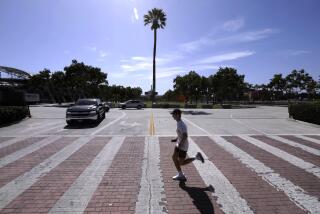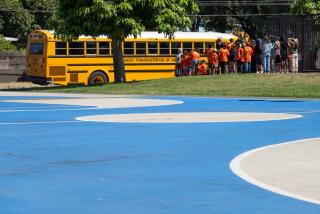White Roofs, Green Trees Help Cool Red-Hot Cities
- Share via
NEW ORLEANS — A little more green and white instead of black can help keep Louisiana’s capital of Baton Rouge cooler, federal scientists say after analyzing infrared photographs of the city.
A NASA-Environmental Protection Agency study showed that white roofs, lighter-colored pavement and trees providing shade to parking lots and streets can reduce heat and pollution in cities that can be 2 to 8 degrees hotter than the areas around them.
The study also included Atlanta, Salt Lake City and Sacramento, and has since spread to Houston, Los Angeles, Chicago and Phoenix.
Fran Stewart, an environmental scientist at the Department of Environmental Quality, reported to NASA and EPA on what Baton Rouge is doing to replace blacktop and add trees.
“I’d like to see pretty much all shade covering all parking areas,” said Peggy Davis, education director for Baton Rouge Green, a group dedicated to planting trees in the city. “I’m hoping for 60%.”
Baton Rouge architect Coleman D. Brown is already convinced that white roofs are best for the commercial buildings he designs. He replaced the coal-tar roof on his business five years ago with an insulated white roof, a move that dropped his monthly air-conditioning bills from about $2,500 to $1,800 or $2,000.
The white roof won’t last as long, but the air-conditioning savings more than make up the difference, he said.
Sacramento already requires new parking lots to include enough trees to shade at least half of the lot after 15 years.
In January, the Sacramento Municipal Utility District plans to offer the nation’s first incentive for white roofs on both homes and commercial buildings, said Ray Tretheway, executive director of the Sacramento Tree Foundation.
“They’re projecting they’ll rebate 20 cents a square foot if you go to a cool roof,” he said.
The Lawrence Berkeley National Laboratory has said that doubling the space shaded by trees and adding several square miles of light surfaces would cut Sacramento’s smoggy days in half, he said.
In Baton Rouge, painting the town white would go a long way toward the city reaching its air quality goal, said Hashem Akbari, head of the Lawrence Berkeley National Laboratory’s urban heat project.
“A lot of roofs are being changed every 10 years. And pavements also need to be resurfaced every seven to eight years. So we are hoping within 10 to 15 years, we would get to that objective,” he said.
*
NASA: https://www.ghcc.msfc.nasa.gov/urban/
Lawrence Berkeley Laboratory: https://EandE.LBL.gov/HeatIslands/
EPA: https://www.livablecommunities.gov
Baton Rouge: https://www.batonrougegreen.com/
Sacramento: https://www.energy.ca.gov/coolcommunity/index.html
More to Read
Sign up for Essential California
The most important California stories and recommendations in your inbox every morning.
You may occasionally receive promotional content from the Los Angeles Times.













